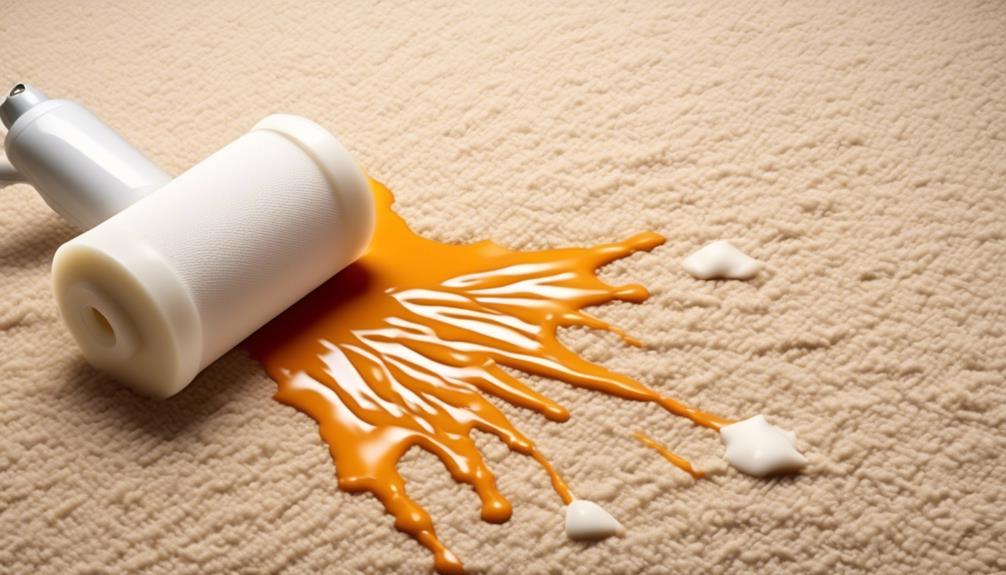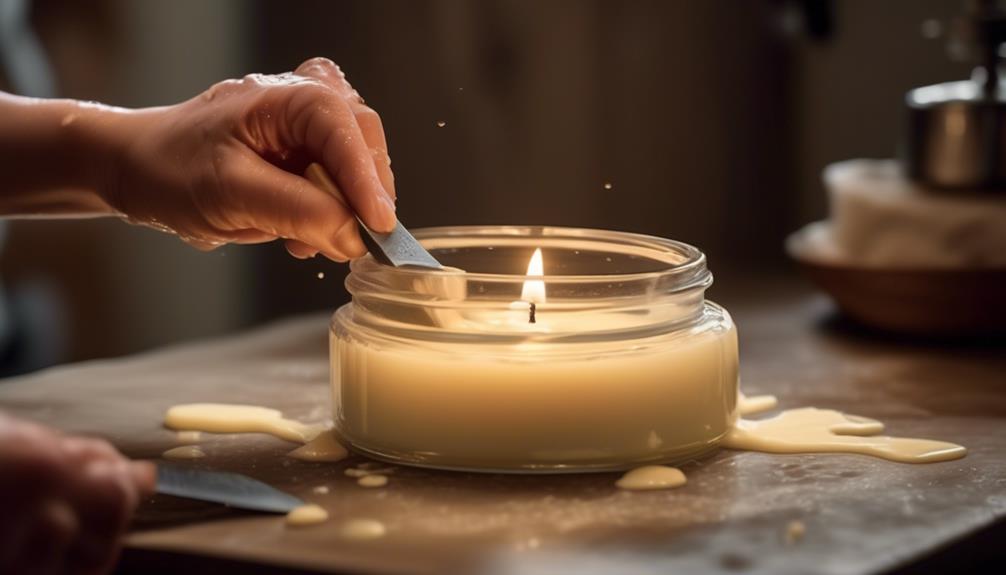After indulging in a romantic candlelit evening, you may find yourself dealing with the unfortunate scenario of wax spilled on your carpet. We understand the frustration this may bring, but fret not, there are ways to effectively tackle this problem.
By following a few straightforward steps, you can bid farewell to that stubborn wax stain. Let's explore some practical methods to restore your carpet to its former glory.
Key Takeaways
- Gather materials: ice pack, scraper, paper bag, warm iron, dry cloth.
- Freeze and scrape off wax using ice and a knife or credit card.
- Cover and clean wax stain with heat, carpet cleaner, and soapy water.
- Use an iron to melt wax, absorb with paper towel, and vacuum treated area.
Gather Necessary Materials
To effectively remove candle wax from carpet, we must first gather the necessary materials for the task ahead. Begin by securing an ice pack or bag of ice to freeze the wax, making it easier to remove. Have a butter knife or scraper on hand to gently lift off the frozen wax without damaging the carpet fibers. Prepare a paper bag or clean towel to absorb the melted wax during the ironing process.
Next, ensure you have a warm iron ready to heat and lift any remaining wax from the carpet fibers. Remember to place the paper bag or towel over the wax before ironing to prevent direct contact with the iron. This will aid in transferring the wax onto the paper bag or towel efficiently.
Freeze the Spilled Wax

We recommend starting the process by applying an ice pack or bag of ice directly onto the spilled wax to freeze it effectively. This method will make the wax hard and brittle, allowing for easier removal without causing damage to the carpet fibers. Here are some steps to freeze the spilled wax successfully:
- Place the ice pack on the wax: Gently press the ice pack or bag of ice onto the spilled wax, covering the affected area entirely.
- Leave it for 5-10 minutes: Allow the ice to chill the wax thoroughly, making it easier to scrape off.
- Check the wax consistency: Test the wax by gently touching it with your fingers to ensure it's frozen and ready for removal.
- Scrape off the frozen wax: Use a butter knife or a credit card to scrape off the now hardened wax carefully.
- Repeat if necessary: If some wax remains, reapply the ice pack and scrape again until the wax is completely removed.
Following these steps will help you effectively remove candle wax from your carpet without causing any further damage.
Scrape off Hardened Wax
After successfully freezing the spilled wax, the next step involves carefully scraping off the now hardened wax from the carpet fibers using a butter knife or a credit card. To remove wax from carpet effectively, it's crucial to scrape the wax gently to avoid damaging the carpet fibers. Start by placing the edge of the butter knife or credit card at the edge of the hardened wax. Apply gentle pressure and scrape as much of the wax off as possible in one direction. Be patient and repeat the scraping process until you have removed all visible traces of the spilled candle wax.
It's essential to avoid using excessive force while scraping to prevent causing further damage to the carpet. If the wax softens during the scraping process, you may need to refreeze it briefly to harden it again before continuing. Once you have scraped off the majority of the wax, you can proceed to the next step of removing any residue left behind on the carpet fibers.
Cover the Wax Stain
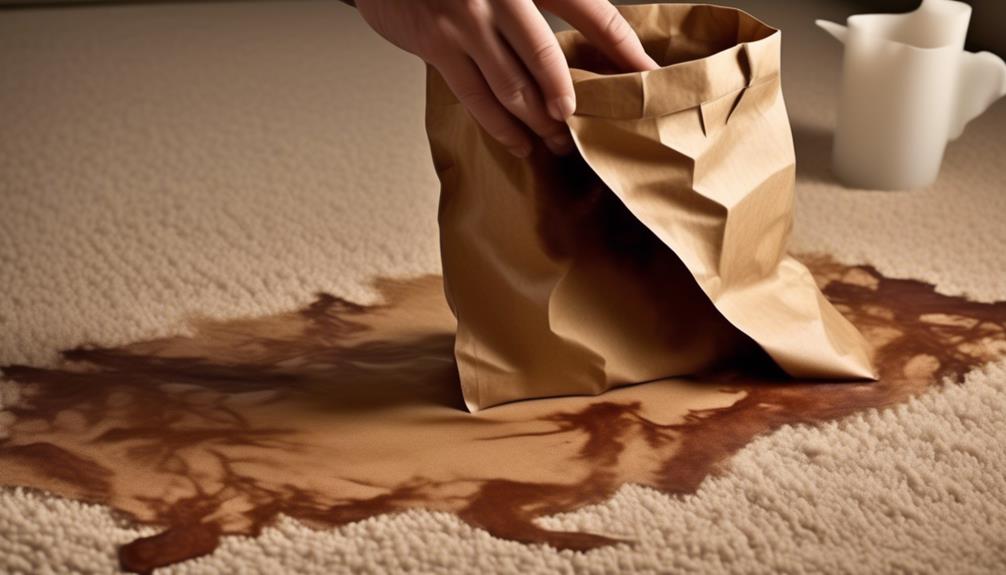
How can we effectively cover the wax stain to prevent further damage to the carpet fibers? Covering the wax stain is crucial to protect the carpet fibers and prevent the wax from spreading. Here are some expert tips to effectively cover the wax stain:
- Place a Clean Cloth: Start by placing a clean cloth or paper towel over the wax stain. This will help absorb some of the wax and prevent it from spreading further.
- Apply Heat: Gently apply a warm iron over the cloth. The heat will help melt the wax, allowing it to be absorbed by the cloth.
- Use a Carpet Cleaner: Apply a small amount of carpet cleaner to the stained area. This will help break down any remaining wax residue and lift the stain from the carpet fibers.
- Blot the Stain: Blot the stained area with a clean cloth to lift the wax stain from the carpet fibers. Avoid rubbing, as this can push the wax deeper into the carpet.
- Consult a Professional Carpet Cleaner: If the stain persists, consider seeking the expertise of a professional carpet cleaner to ensure the stain is fully removed without damaging the carpet fibers.
Iron to Melt the Wax
To effectively address the wax stain on the carpet, the application of heat using an iron is a crucial step in melting the wax for removal. Place a clean white towel over the wax spills on the carpet. Then, set the iron to a low heat setting and gently run the iron over the towel. The heat from the iron will cause the wax to melt and transfer onto the towel, helping to lift the wax stain from the carpet fibers.
As the iron heats the towel, the wax will begin to soften and liquefy, allowing the towel to absorb the melted wax. It's important to keep the iron moving and not leave it in one spot for too long to prevent burning the carpet fibers. Continue this process until the wax has been completely transferred from the carpet to the towel.
Check the towel periodically and reposition it to a clean area to ensure maximum absorption of the wax stain. This method effectively combines heat to melt the wax and absorb it, leaving your carpet clean and wax-free.
Use BISSELL® Oxy Deep® Pro
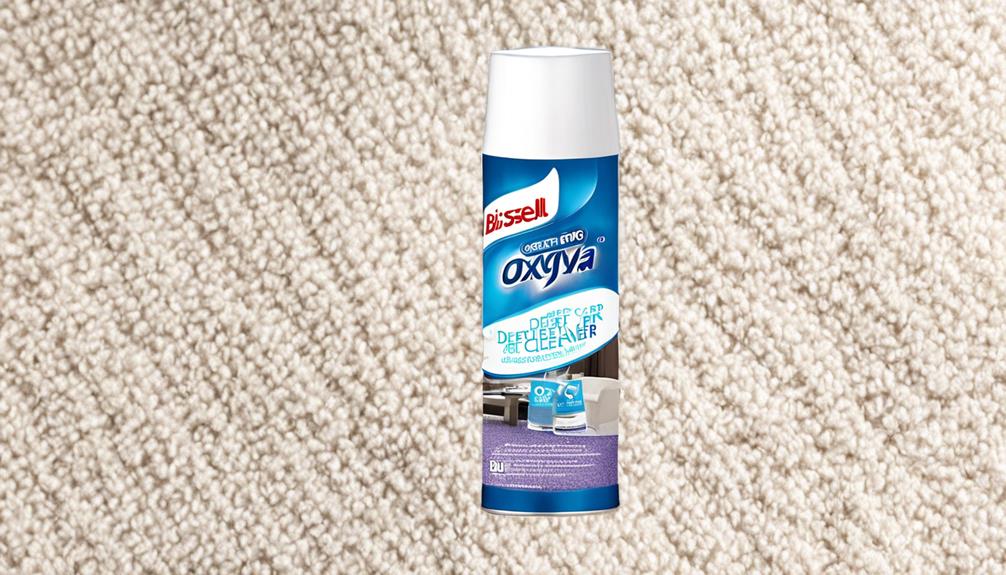
When dealing with candle wax stains on your carpet, utilizing the BISSELL® Oxy Deep® Pro carpet cleaner spray can be highly effective.
This specialized cleaner is designed to target tough stains like wax, making it a reliable choice for restoring your carpet's appearance.
Oxy Deep Pro Benefits
Utilizing BISSELL® Oxy Deep® Pro provides a superior solution for effectively removing stubborn candle wax from carpets. This advanced cleaning formula is specifically designed to tackle tough stains like wax, ensuring your carpet looks pristine.
Here are some benefits of using BISSELL® Oxy Deep® Pro:
- Deep Cleaning: Penetrates deep into carpet fibers to lift out stubborn wax residue.
- Stain Removal: Targets and eliminates wax stains, leaving your carpet spotless.
- Quick Action: Works efficiently to remove wax out of the carpet, saving you time and effort.
- Protects Carpet: Helps maintain the carpet's quality by gently cleaning without causing damage.
- Professional Results: Achieve professional-level cleaning outcomes without the hassle.
Experience the power of BISSELL® Oxy Deep® Pro for a thorough cleaning that removes wax from your carpet effectively.
Application Instructions
Having discussed the benefits of BISSELL® Oxy Deep® Pro for removing stubborn candle wax from carpets, let's now explore the proper application instructions for using this powerful cleaning solution.
To begin, ensure the affected area is free of any debris or loose wax particles.
Then, shake the BISSELL® Oxy Deep® Pro bottle well and apply a generous amount directly onto the wax stain.
Allow the solution to penetrate the wax for approximately 5-10 minutes to break down the residue effectively.
Next, using a clean, white cloth or sponge, gently blot the area to lift the dissolved wax.
Repeat this process if necessary until the wax is completely removed.
Precautions to Consider
To ensure successful removal of candle wax from your carpet using BISSELL® Oxy Deep® Pro, it's crucial to carefully read and follow the instructions provided on the product's bottle. When tackling this task, there are several precautions to consider:
- Test the spot cleaner on a clean white towel on top of an inconspicuous area of the carpet first.
- Use the spot cleaner only as directed to avoid any mishaps.
- Avoid over-saturating the carpet to prevent potential damage.
- When using heat or steam to iron the wax stain, be cautious to protect the carpet fibers.
- Allow the carpet to dry completely before walking on it or placing furniture to prevent re-soiling.
Let the Carpet Dry Completely

After thoroughly treating the candle wax stain, it's crucial to allow the carpet to dry completely before proceeding with further removal techniques. To let the carpet dry completely, gently blot any excess moisture with a clean, dry cloth. Ensure proper ventilation in the room to expedite the drying process. Avoid walking on the damp area to prevent spreading the wax stains or causing damage to the fibers.
If the wax stain persists after drying, consider using ice or an ice pack to freeze the remaining wax. Place the ice on top of the wax for a few minutes until the wax hardens. Once hardened, carefully scrape off the wax using a butter knife or a plastic card, being cautious not to pull the carpet fibers.
Once you have removed as much wax as possible, clean the wax residue using a solution of warm water and mild dish soap. Blot the area with the soapy water and a clean cloth, then follow up with a clean, damp cloth to rinse. Allow the carpet to dry completely before assessing the effectiveness of the removal process.
Vacuum the Treated Area

Once the treated area has dried completely, it's crucial to vacuum the carpet thoroughly to ensure all remnants of wax and cleaning solution are removed.
Using the upholstery brush attachment on the vacuum will help restore the texture of the carpet while efficiently cleaning the area.
Pay attention to the treated spot, and if needed, repeat the vacuuming process until the carpet achieves the desired cleanliness.
Heat and Lift
We recommend applying heat to the wax on the carpet and then promptly using a vacuum to lift away the treated area. When dealing with wax on carpet, this method can effectively remove the stubborn residue.
Here are some key steps to follow:
- Apply Heat: Use an iron on a low setting or a hairdryer to melt the wax.
- Place a Paper Towel: Put a paper towel over the wax to absorb the melted wax.
- Cool and Solidify: Let the wax cool and solidify again.
- Vacuum the Area: Use a vacuum cleaner to lift the hardened wax from the carpet fibers.
- Repeat if Necessary: If there's remaining wax, repeat the process until the carpet is clean.
Use Paper Towels
To effectively remove the melted wax from the carpet, proceed by gently blotting the treated area with paper towels before using a vacuum to lift away the residue. The paper towel will absorb the wax as it becomes wet, aiding in the removal process. Ensure that you press down firmly to allow the paper towel to absorb as much wax as possible.
Repeat this process with fresh paper towels until no more wax transfers onto them. Once the majority of the wax has been absorbed, use a vacuum cleaner to remove any remaining particles from the carpet fibers.
This method helps to restore the carpet's appearance and prevents any wax remnants from causing damage over time.
Try a Rug Doctor Machine

Consider utilizing a Rug Doctor machine for effectively tackling stubborn candle wax stains embedded in your carpet fibers. Rug Doctor machines offer professional-level cleaning results, making them a reliable choice for wax removal.
Here's a guide to using a Rug Doctor machine for this purpose:
- Use a Rug Doctor machine: Rent or purchase a Rug Doctor machine for powerful extraction of wax from your carpet.
- Utilize a portable spot cleaner attachment: Target any leftover wax residue with precision using this attachment.
- Apply an ice pack: Harden the wax by placing an ice pack on it, making it easier to scrape off with a butter knife.
- Employ a hair dryer: Heat the wax stain with a hair dryer to melt it, then blot it up with a clean cloth.
- Consider using rubbing alcohol: Dab a cloth with rubbing alcohol to lift any remaining wax residue from the carpet fibers.
Find a Rug Doctor Stockist
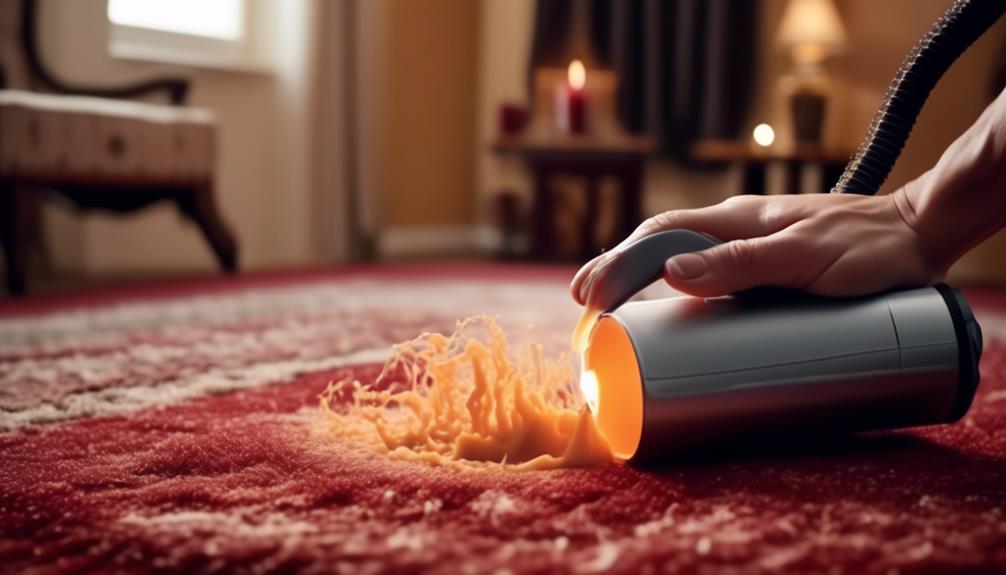
When seeking to remove candle wax from carpet, one must first find a Rug Doctor stockist.
By utilizing the store locator, we can easily identify the nearest stockist offering Rug Doctor machines for hire.
Contacting the stockist ensures availability and convenience in accessing professional-grade cleaning equipment for efficient wax removal.
Locate Nearby Rug Doctor
For access to professional-grade cleaning equipment for wax removal, easily locate the nearest Rug Doctor stockist using the store locator. When searching for a Rug Doctor stockist, consider the following:
- Convenient Availability: Find a stockist near you to ensure easy access to Rug Doctor machines.
- Professional Solutions: Stockists offer access to high-quality cleaning equipment for effective wax removal.
- Hassle-Free Hire: Rent a Rug Doctor machine from the nearest stockist for your carpet cleaning needs.
- Expertise at Hand: Benefit from the expertise of Rug Doctor professionals when using their machines.
- Efficient Cleaning: Utilize Rug Doctor machines to efficiently remove wax from your carpet using techniques like using an ice bag or paper bag.
Check Stockist Availability
Utilize the Rug Doctor store locator tool to swiftly pinpoint the nearest stockist offering professional-grade cleaning equipment for efficient wax removal from your carpet. Before heading out, ensure the stockist has Rug Doctor machines available for hire to meet your wax removal needs promptly.
| Stockist Location | Availability of Rug Doctor Machines | Contact Information |
|---|---|---|
| City A | Yes | 555-123-4567 |
| City B | Yes | 555-987-6543 |
| City C | No | 555-456-7890 |
When contacting the stockist, inquire about the availability of features like a steam function to aid in removing dried wax effectively. It's essential to have access to the right tools, such as brown paper and ice, for a successful wax removal process.
Contact for Rental
To locate the nearest Rug Doctor stockist for accessing professional-grade cleaning equipment, swiftly pinpoint their availability through the store locator tool.
When dealing with wax drips on Berber carpets, these steps are crucial for securing the right equipment:
- Utilize the store locator to find the closest Rug Doctor stockist.
- Stockists offer Rug Doctor machines for hire, ensuring access to quality cleaning tools.
- Easily locate a stockist for quick and convenient wax removal solutions.
- Verify the availability of Rug Doctor machines in your area before planning the rental.
- Access professional-grade cleaning equipment through stockists to effectively remove wax stains. Remember to gently dab the stain and allow the wax to solidify before cleaning for best results.
Frequently Asked Questions
What's the Best Thing to Get Candle Wax Out of Carpet?
We find that addressing candle wax on carpet involves a methodical approach.
First, freeze the wax with an ice pack to harden it, then gently scrape it off.
Next, cover the residue with a paper bag and iron on low heat to lift the remaining wax.
Finally, treat the area with a carpet cleaner spray, like Oxy Deep® Pro, and vacuum once dry.
This systematic process ensures thorough removal without damaging the carpet fibers.
Will Rubbing Alcohol Remove Candle Wax From Carpet?
We've found that rubbing alcohol is effective in removing candle wax from carpet. It's crucial to test it in a small area first to avoid damage.
Apply a small amount of rubbing alcohol to a clean cloth and gently blot the wax stain from the edges towards the center. Continue until the wax is gone.
Afterward, use a carpet cleaner to eliminate any residue or staining for a spotless finish.
How Does Vinegar Remove Candle Wax From Carpet?
When removing candle wax from carpet, vinegar can be effective due to its acidic properties.
Vinegar helps break down the wax, making it easier to lift off the carpet fibers.
By applying vinegar and gently blotting the affected area with a clean cloth, the wax should start to dissolve and transfer onto the cloth.
Repeat this process until the wax is fully removed, then follow up with a carpet cleaner spray to eliminate any residue.
What Removes Spilled Candle Wax?
When addressing what removes spilled candle wax, a combination of cold treatment and gentle scraping can effectively tackle the issue. Freezing the wax with ice and then carefully removing it with a tool like a butter knife sets the stage for successful removal.
This method shows promise in handling such mishaps with relative ease and minimal damage to the carpet fibers.
Conclusion
In conclusion, removing candle wax from carpet may seem daunting, but with the right tools and techniques, it can be done effectively.
Remember, 'where there's a will, there's a way.' By following the steps outlined, you can successfully get rid of the wax stain and restore your carpet to its original condition.
Don't let a little spilled wax ruin your day – tackle the problem head-on and enjoy a clean, wax-free carpet once again.
